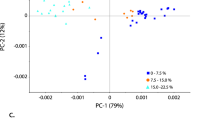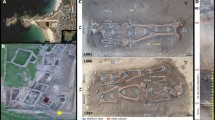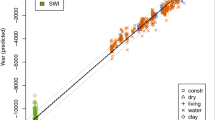Abstract
Smith et al. have shown an interesting correlation between the thermal age of Pleistocene–Holocene fossils and ancient DNA retrieval and advocate using this criterion to assess the merit of subjecting ancient bones to destructive analysis, particularly any scientifically valuable bones of Neanderthals and anatomically pre-modern humans. The post-mortem DNA quality is, of course, dependent on the surrounding temperature, but — as the authors point out — many other important factors influence fossil DNA preservation, such as air and soil humidity, soil pH, phosphorus content of the soil, average temperature in different earth layers, and microbial-mediated decay, which also have to be taken into account.
Similar content being viewed by others
Ovchinnikov et al. reply
The complex interaction of several factors is illustrated by differential preservation of skeletons and bones from the same site, and even between different parts of the same skeleton or mummy. In addition, some specimens recovered from permafrost or glacial conditions after present-day thawing have shown variable degrees of mitochondrial DNA preservation (for example, in the Tyrolean Ice Man1) or they contained no recoverable mitochondrial DNA (as discovered in the Altai Princess and Warrior mummies; I.V.O. and W.G., manuscript in preparation), illustrating that low temperatures alone are not sufficient to preserve all specimens.
Relying too heavily on temperature alone could lead to important specimens being excluded from DNA analysis. The Feldhofer Neanderthal is an outlier based on this model, which would predict that the possibility of recovering fossil DNA from this specimen would be very remote. Obtaining a sample of the Feldhofer Neanderthal for destructive analysis would presumably have been even more difficult if too much significance had been placed on such a model at the time the work was carried out.
Another example for which the thermal age may not be an accurate guide to the state of preservation is the Neanderthal recovered from the Marillac Cave in France. As this has a thermal age of 30,539 years, the model would predict that there should be very little chance of fossil DNA remaining. However, the collagen yield is comparable to that of the Mezmaiskaya Neanderthal, which had very good DNA preservation2,3.
In conclusion, we agree that there is a real correlation between DNA survival and thermal history, but the accuracy to which the survival of DNA can be predicted is limited. Important specimens could be overlooked if too much emphasis is placed on the thermal age alone.
References
Handt, O. et al. Science 264, 1775–1778 (1994).
Bocherens, H. et al. J. Hum. Evol. 20, 481–492 (1991).
Ovchinnikov, I. V. et al. Nature 404, 490–493 (2000).
Author information
Authors and Affiliations
Corresponding author
Rights and permissions
About this article
Cite this article
Ovchinnikov, I., Götherström, A., Romanova, G. et al. Not just old but old and cold?. Nature 410, 772 (2001). https://doi.org/10.1038/35071181
Issue Date:
DOI: https://doi.org/10.1038/35071181
Comments
By submitting a comment you agree to abide by our Terms and Community Guidelines. If you find something abusive or that does not comply with our terms or guidelines please flag it as inappropriate.



